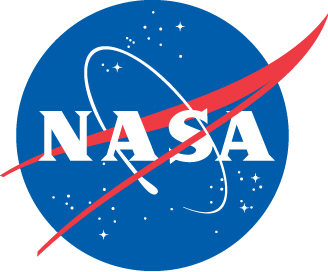Biodiversity as an Indicator of Global Climate Change
About This Module
Topics: Climate, Biodiversity, Ecosystem Impacts, Greenhouse Gases, CO2-driven Changes, Temperature Anomalies
Grade Levels: 9-12
Scenario
Scientists have long recognized that many species on Earth come and go with varying environmental conditions, natural competition, and changes in habitats and climates. Think of the multiple theories surrounding the extinction of the dinosaurs!

The Siberian tiger is critically endangered. Three subspecies of tigers are already extinct.
The decline in biodiversity (the number of different species of organisms on Earth) that has occurred in the last few decades, however, is a rapid decline. From what we learn from studying rock records, it is a much more rapid decline than any other in Earth’s history.
Many people scoff at the idea of a biodiversity decline.
News stories about the possible extinction of a salamander, a population crash of the ivory-billed woodpecker, or an endangered freshwater stingray have some people wondering why these animals are important to them. There are more salamanders, more birds, and more stingrays, right? So what if we lose a few? Those people would be very surprised at the answer.
Biodiversity loss threatens human security and well-being. Food chains on which we depend will be disrupted, water sources may disappear, and medicines and other resources obtained from lost organisms—or the organisms that depend on them—could be lost to us.
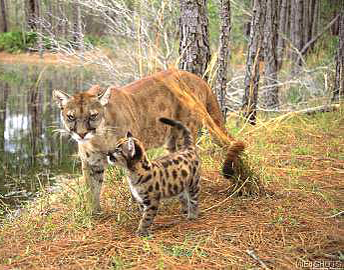 The North American cougar is critically endangered. http://en.wikipedia.org/wiki/North_American_Cougar
The North American cougar is critically endangered. http://en.wikipedia.org/wiki/North_American_CougarClimate change seems to be a major driver of the loss of biodiversity, and it is predicted to have an even greater impact in the decades to come. Melting Arctic sea ice, ocean acidification, warming temperatures, extreme weather events, and rising sea levels will have a devastating effect on some species.
In 2002 a Convention on Biological Diversity was held in The Hague, Netherlands, to address threats to Earth’s ecosystems. Given the state of rainforest deforestation, habitat destruction, and predicted global climate change, world leaders promised to "strengthen our efforts to halt biodiversity loss, which is taking place at an alarming rate...by the year 2010."
In 2010, the International Year of Biodiversity, scientists were still talking about threats to Earth’s biodiversity. While scientists attempt to focus the world’s attention and raise awareness of the fragile state of some of Earth’s ecosystems, things are worse.
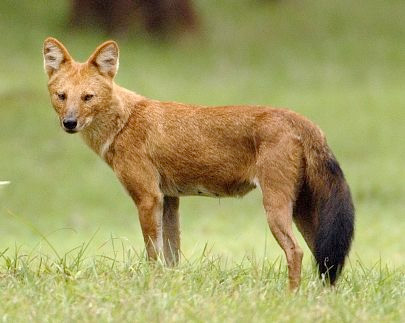
The dhole is on the edge of extinction. It is the most endangered Asiatic top predator.
In a study published in Science magazine, scientists and environmentalists concluded: "Our analysis suggests that biodiversity has continued to decline over the past four decades, with most state indicators showing negative trends."
It’s not like we have totally ignored the problem. Responding to research results, some governmental policies have improved. More countries are setting aside protected lands and are managing resources for sustainability. Global pacts and agreements have included provisions for conservation and tackling the problems of invasive species.
Why have our efforts fallen somewhat short of the mark? Some scientists suggest that our strategies so far, while important, may not be enough to offset the trends in global climate change. Some progress has been made, but strong, concentrated efforts are needed now if we are to protect our planet’s biodiversity.
Task: Biodiversity and Global Climate Change
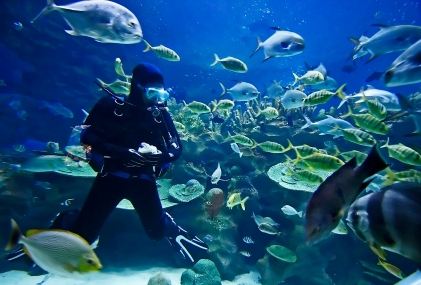
For your work on the United States Panel on Global Climate Change Research, you and your team of ecologists and environmental scientists have been studying some of the most exotic places on Earth.
Team members have scuba-dived around massive, colorful coral reefs, studied deep ocean water onboard submersibles, hiked through rainforests, and taken samples of grassland soils in Kansas and the Zambezi River basin in Africa.
Your major task has been to study Earth’s biodiversity and its importance. Biodiversity is the number different kinds of plant and animal species in a natural environment.
With a major international conference looming, you must now apply climate change information and the data you collected to make a prediction about the world 30 years from now. Your colleagues are gathered to share their experiences and their preliminary findings with the rest of your group.
This International Panel on Climate Change conference requires more than a standard report citing data and displaying results in tables and graphs. Thorough analysis of the data is required to present an accurate picture of Earth’s biodiversity. Climate changes have been the focus of heated controversy and debate for the last decade. As a scientist, you naturally look at the data from purely objective perspectives.
An important element of the ongoing research on global climate change is the study of how any climate changes might affect biodiversity. Understanding the mechanisms behind potential climate changes will allow you to make accurate predictions of the impacts to organisms because of environmental changes.
Your team is tasked with researching the predicted climate changes and the corresponding impact, if any, that the change will have on biodiversity. Your team must report both the changes and consequences. Once an accurate assessment is made, the panel can move on to resolutions that might alleviate any negative impacts.
Task: Describe to the international panel Earth’s biodiversity 30 years from now.
In order to present accurate, complete, and valid findings, you should consider the following:
1) What do the data indicate about Earth’s biodiversity? Identify any trends that occurred in biodiversity.
Think “before and after” to help you identify a big picture of the biodiversity on Earth and the changes that may have occurred over decades.
2) What are the impacts of changes to Earth’s physical environments on species diversity? Remember to report the impacts to humans, wildlife, ecosystems, etc.
How are Earth’s environments changing? How does this affect species diversity?
3) What appears to be the source(s) of the changes? Can you identify a major cause?
This is very important to understanding the mechanisms that drive the change and, therefore, important to finding a possible remediation of the impacts.
4) What are the impacts of changes in Earth’s biodiversity?
Potential impacts of changes in Earth’s biodiversity are serious. Consider all impacts, not only to those species directly affected, but to those that might be affected as a consequence. The International Panel on Climate Change will need to know impending impacts in order to plan for the future.
5) What strategies do you see that could mitigate or lessen decreased species diversity? How long would the strategies take to make a difference?
Some members of the panel have already discussed some questions in addition to those above. Be prepared to answer the following:
- If environments lose species, will other species take their place?
- Describe the mass extinctions in Earth’s history. How are these similar or different from today’s extinctions?
- If the environment changes, it might no longer be optimal for some existing species, but it might be beneficial to other species. Why isn’t this necessarily a good situation?
Sample Rubrics
The developing rubrics page in the Problem Based Learning section provides a content-specific rubric for the Global Temperatures module under the Sample Rubrics heading.
Resources
NASA Eyes on Earth—Global Climate Change
http://climate.nasa.gov/
This comprehensive site provides valuable information on climate change indicators, including data, graphs, scientific investigations, and animations for a range of grade levels.
NASA—Earth Observatory—Deforestation
http://earthobservatory.nasa.gov/Features/Deforestation/
NASA Earth Observatory—Global Warming
http://earthobservatory.nasa.gov/Features/GlobalWarming/
Basics about global climate changes and links to additional resources and information.
Environmental Protection Agency—Climate Change and Biodiversity
http://epa.gov/climatechange/effects/eco.html
Discovery Earth: Mass Extinctions
http://dsc.discovery.com/earth/wide-angle/mass-extinctions-timeline.html
Biodiversity 911
http://www.biodiversity911.org/
Ecological Society of America—Biodiversity
http://www.esa.org/education_diversity/pdfDocs/biodiversity.pdf
Hotspots: Understanding and Conserving the Earth’s Biodiversity Hotspots—A Biodiversity Research Network
http://www.hotspots-e-atlas.eu/
Global Warming—Frequently Asked Questions
http://lwf.ncdc.noaa.gov/oa/climate/globalwarming.html
Basics to global climate change in a question-answer format with graphs to illustrate main topics and climate mechanisms.
Climate Change—U.S. Environmental Protection Agency
http://www.epa.gov/climatechange/
This comprehensive site provides in-depth information on a wide variety of climate change topics. A great research tool.
Climate Change Indicator Report—U.S. EPA
http://www.epa.gov/climatechange/indicators.html
Climate change indicator study full report and slide show. Individual chapters are also available for print and include topics such as greenhouse gases, weather and climate, oceans, snow and ice, and summary of key findings.
High School Environmental Center
http://www.epa.gov/highschool/
This U.S. EPA site covers environmental topics such as air, water, conservation, ecosystems, waste and recycling, and health and safety. The “Your Neighborhood” section provides links to information about how you can apply environmental issues to your local community.
Scenario Images
Go to Biodiversity Featured Data ![]()
Percentages of Species in Threat Categories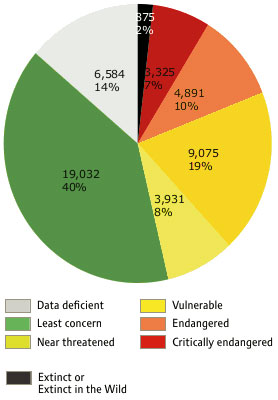
This pie chart (above) shows percentages of species in threat categories of extinction risk. Based on data from 47,677 species, percentages were compiled by the International Union for the Conservation of Nature (IUCN). The IUCN Red List is a comprehensive assessment of the status of Earth’s biological species.
Source: IUCN compiled by Secretariat of the Convention on Biological Diversity. (2010, May). Global Biodiversity Outlook 3.
Threat Status of Species by IUCN
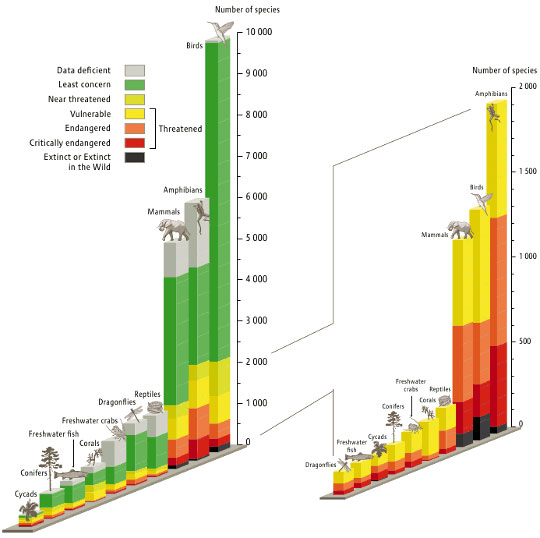
This graph shows the threat status of species as assessed by the International Union for the Conservation of Nature (IUCN).
The graph in the Featured Data section of the Biodiversity module provides more detail for the threatened species category.
Source: IUCN compiled by Secretariat of the Convention on Biological Diversity. (2010, May). Global Biodiversity Outlook 3.
My NASA Data-related Lesson Plans
Coral Bleaching in the Caribbean
Students use authentic satellite data to determine when the sea surface temperature meets the criteria to induce coral bleaching. Appropriate for grades 5-12.
https://mynasadata.larc.nasa.gov/preview_lesson.php?&passid=51
March of the Polar Bears: Global Change, Sea Ice, and Wildlife Migration
Students will use NASA satellite data to study temperature and snow-ice coverage in the South Beaufort Sea, Alaska. The data can be used to correlate with USGS ground tracking of polar bears and to relate this to global change, sea ice changes, and polar bear migration. The data can be used to draw conclusions surrounding any migration patterns in the region. Appropriate for grades 7-12.
https://mynasadata.larc.nasa.gov/preview_lesson.php?&passid=90
Evidence of Change Near the Arctic Circle
To analyze graphs as evidence and make a conclusion about polar climate change. Appropriate for grades 8-12.
https://mynasadata.larc.nasa.gov/preview_lesson.php?&passid=98
Standards
National Science Standards Addressed
As a result of activities in grades 9-12, all students should develop understanding of:
Content Standard A
USE TECHNOLOGY AND MATHEMATICS TO IMPROVE INVESTIGATIONS AND COMMUNICATIONS. The use of computers for the collection, analysis, and display of data is also a part of this standard.
FORMULATE AND REVISE SCIENTIFIC EXPLANATIONS AND MODELS USING LOGIC AND EVIDENCE. Student inquiries should culminate in formulating an explanation or model. Models should be physical, conceptual, and mathematical. In the process of answering the questions, students should engage in discussions and arguments that result in the revision of their explanations. These discussions should be based on scientific knowledge, the use of logic, and evidence from their investigation.
RECOGNIZE AND ANALYZE ALTERNATIVE EXPLANATIONS AND MODELS. This aspect of the standard emphasizes the critical abilities of analyzing an argument by reviewing current scientific understanding, weighing the evidence, and examining the logic so as to decide which explanations and models are best.
COMMUNICATE AND DEFEND A SCIENTIFIC ARGUMENT. Students in school science programs should develop the abilities associated with accurate and effective communication. These include writing and following procedures, expressing concepts, reviewing information, summarizing data, using language appropriately, developing diagrams and charts, explaining statistical analysis, speaking clearly and logically, constructing a reasoned argument, and responding appropriately to critical comments.
UNDERSTANDINGS ABOUT SCIENTIFIC INQUIRY
- Scientists usually inquire about how physical, living, or designed systems function. Conceptual principles and knowledge guide scientific inquiries. Historical and current scientific knowledge influence the design and interpretation of investigations and the evaluation of proposed explanations made by other scientists.
- Scientists conduct investigations for a wide variety of reasons. For example, they may wish to discover new aspects of the natural world, explain recently observed phenomena, or test the conclusions of prior investigations or the predictions of current theories.
- Scientists rely on technology to enhance the gathering and manipulation of data. New techniques and tools provide new evidence to guide inquiry and new methods to gather data, thereby contributing to the advance of science. The accuracy and precision of the data, and, therefore, the quality of the exploration, depend on the technology used.
- Mathematics is essential in scientific inquiry. Mathematical tools and models guide and improve the posing of questions, gathering data, constructing explanations and communicating results.
- Human beings live within the world's ecosystems. Increasingly, humans modify ecosystems as a result of population growth, technology, and consumption. Human destruction of habitats through direct harvesting, pollution, atmospheric changes, and other factors is threatening current global stability, and if not addressed, ecosystems will be irreversibly affected.
- The distribution and abundance of organisms and populations in ecosystems are limited by the availability of matter and energy and the ability of the ecosystem to recycle materials.
Content Standard C
Life Science
The Interdependence of Organisms
Content Standard D
Earth and Space Science
ENERGY IN THE EARTH SYSTEM
-
Global climate is determined by energy transfer from the sun at and near the earth's surface. This energy transfer is influenced by dynamic processes such as cloud cover and the Earth's rotation and static conditions such as the position of mountain ranges and oceans.
GEOCHEMICAL CYCLES
-
Movement of matter between reservoirs is driven by the Earth's internal and external sources of energy. These movements are often accompanied by a change in the physical and chemical properties of the matter. Carbon, for example, occurs in carbonate rocks such as limestone, in the atmosphere as carbon dioxide gas, in water as dissolved carbon dioxide, and in all organisms as complex molecules that control the chemistry of life.
Content Standard E
Science and Technology
EVALUATE THE SOLUTION AND ITS CONSEQUENCES.
Students should test any solution against the needs and criteria it was designed to meet. At this stage new criteria not originally considered may be reviewed.
COMMUNICATE THE PROBLEM, PROCESS, AND SOLUTION. Students should present their results to students, teachers, and others in a variety of ways, such as orally, in writing, and in other forms—including models, diagrams, and demonstrations.
- The organizing principles for this standard do not identify specific personal and societal challenges; rather, they form a set of conceptual organizers, fundamental understandings, and implied actions for most contemporary issues. The organizing principles apply to local as well as global phenomena and represent challenges that occur on scales that vary from quite short—for example, natural hazards—to very long—for example, the potential result of global changes. Includes:
- Natural resources
- Environmental quality
- Natural and human-induced hazards
- Science and technology in local, national, and global challenges
Content Standard F
Science in Personal and Social Perspectives
ENVIRONMENTAL QUALITY
- Natural ecosystems provide an array of basic processes that affect humans. Those processes include maintenance of the quality of the atmosphere, generation of soils, control of the hydrologic cycle, disposal of wastes, and recycling of nutrients. Humans are changing many of these basic processes, and the changes may be detrimental to humans.
- Materials from human societies affect both physical and chemical cycles of the Earth.
- Many factors influence environmental quality.
NATURAL AND HUMAN-INDUCED HAZARDS
- Natural and human-induced hazards present the need for humans to assess potential danger and risk. Many changes in the environment designed by humans bring benefits to society as well as cause risks. Students should understand the costs and trade-offs of various hazards—ranging from those with minor risk to a few people to major catastrophes with major risk to many people.
SCIENCE AND TECHNOLOGY IN LOCAL, NATIONAL, AND GLOBAL CHALLENGES
- Understanding basic concepts and principles of science and technology should precede active debate about the economics, policies, politics, and ethics of various science- and technology-related challenges.
- Humans have a major effect on other species. For example, the influence of humans on other organisms occurs through land use—which decreases space available to other species—and pollution—which changes the chemical composition of air, soil, and water.
Content Standard G
History and Nature of Science
NATURE OF SCIENTIFIC KNOWLEDGE
- Data concerning some scientific topics are incomplete, such as the details of human evolution or questions surrounding global warming. New data may well lead to changes in current ideas or resolve current conflicts. In situations where information is still fragmentary, it is normal for scientific ideas to be incomplete, but this is also where the opportunity for making advances may be greatest.
National Science Content Standards: http://www.nap.edu/openbook.php?record_id=4962&page=103

